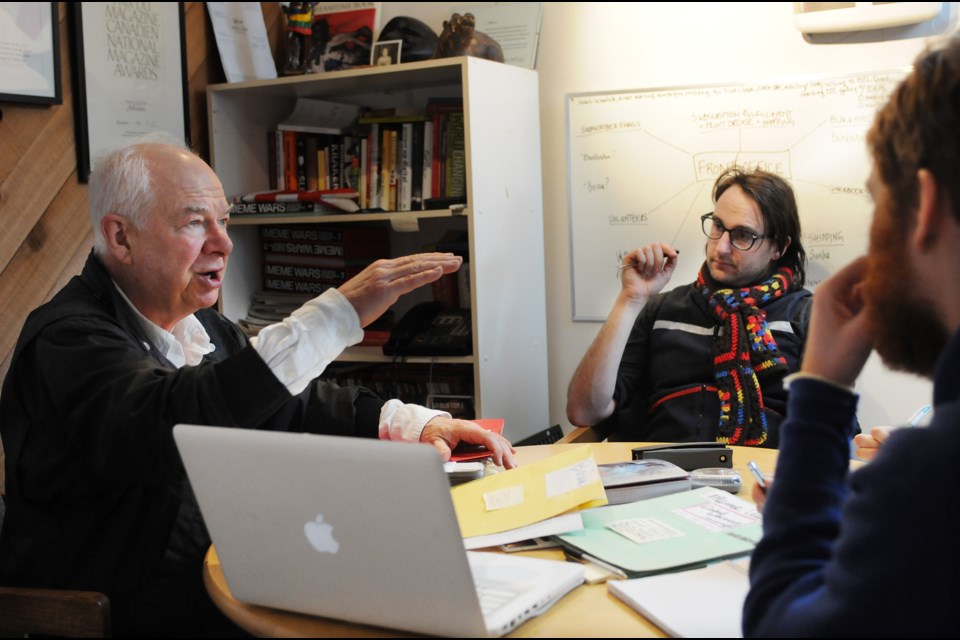The nerve centre of Adbusters magazine — the not-for-profit, counter-culture publication credited with sparking the Occupy Wall Street movement — can be found in the basement of a weathered, brownish-red, 125-year-old house on a quiet tree-lined street in Vancouver’s Fairview neighbourhood.
According to its co-founder Kalle Lasn, Adbusters was launched in 1989 as an outlet for his anti-establishment rage, which had been fuelled by the CBC’s refusal to air the then-young environmentalist filmmaker’s 30-second anti-forestry TV spot.
From Adbusters’ bare bones offices, Lasn and a revolving door of young, passionate university students, artists and self-described revolutionaries have consistently churned out six editions of the magazine a year — all without advertising.
Adbusters is best known for its parody advertisements, such as the one of Tiger Woods with a Nike Swoosh for a smile that went viral, and for its anti-corporation art and articles.
Langara journalism magazine instructor Robert Dykstra said the media landscape needs to have dissenting voices such as Adbusters challenging the status quo. It also turns the traditional funding of media on its head.
The magazine is supported by its sales — $12.95 on newsstands and $25 a year for a digital subscription — private donations and revenue from its Blackspot Shoes line of “sweatshop free” vegan sneakers.
While consumer magazines and newspapers survive by selling readers to advertisers, Adbusters sells content to readers.
“Meaning it’s reader-driven, instead of advertiser-driven,” Dykstra added.
Though many other consumer, advertising-sponsored print publications have fallen victim to the sway of the Internet and the ups and downs of the economy, Adbusters has prevailed.
Lasn, 72, said the secret is that those behind the magazine have always focused on advocacy and activism, not revenue.
“We started out as a work of passion and I think this ethic, even though we have grown… is still there among most of us,” Lasn said.
“And when you have a passion like that then, you know, the usual stuff doesn’t really matter. Somehow people are willing to work for less, to fight harder, they are willing to work until four o’clock in the morning, or deadline time if necessary. They are willing to go beyond the call of duty and this is the secret of our survival, the fact that we aren’t just the business model.”
While the passion that fuels the magazine has remained the same, Lasn said the goals of the Adbusters Media Foundation, which publishes Adbusters, and the magazine itself, have shifted.
In the beginning, Lasn said he wanted to tweak the system, but 10 years ago he began to agitate instead for a complete toppling of the capitalist system.
Lasn got his chance to agitate for upheaval in the summer of 2011.
Inspired by the revolutions in Tunisia and Egypt, Adbusters called for an occupation of Wall Street on Sept. 17, Lasn’s mother’s birthday, in the pages of the magazine. They also created occupywallstreet.org and sent out a flurry of “tactical briefings” to its 100,000 followers calling for the same thing.
The movement took off and so did the magazine’s sales, reaching a worldwide circulation of 120,000 shortly after Occupy began, Lasn said.
Almost three years later, circulation sits at 35,000 and the tents that once filled protest encampments in at least 951 cities in 82 countries around the world have been folded up.
But Lasn bristles at the suggestion the Occupy movement has fizzled out.
“The feeling in the park may be dead, but the spirit of Occupy is gaining strength like I have never seen it before,” he said, citing examples such as the once imprisoned members of the punk band Pussy Riot in Russia, education reformers in Chili and uprisings in Istanbul and Brazil as proof young people around the world are still refusing to accept the future that is being offered to them.
Indeed, much of Adbusters’ success as a magazine and in sparking revolutionary action depends on the passion of youth.
The magazine’s target audience has always been young rebels who often drop the magazine when they enter the work-a-day life of later adulthood.
“We all change as we start getting older and acquire things, we kind of get more entrenched and often get more conservative,” said Dykstra.
Lasn admitted many people approach him to say they used to read his magazine when they were in school but no longer do.
Luckily for Adbusters there always seems to be more young people willing to take up the revolutionary mantle.
When the Courier paid the office a visit, the four workers present were under 30 years old and a young 20-something bespectacled student sat waiting to be interviewed for a position.
With the goal of influencing what Lasn calls the “Satori” (a Japanese Buddhist term for enlightened), he and his team have many other projects on the go, such as the Kickitover.org campaign aimed at getting economic students to challenge their professors’ assertions on the success of capitalism and a video game to capture the imaginations of young potential revolutionaries.
thuncher@shaw.ca



